Introduction
The avocado Persea americana Mill., belongs to the Lauraceae family, originally found in Guatemala, Central part of America and Mexico (Knigh, 2007; Sánchez, 1999). It is distributed from Mexico to Peru, throughout Central America, Colombia, Venezuela and Ecuador (Knigh, 2007).
The avocado is an important crop worldwide with a global production of 4.717.102 metric tonnes (MT). The main producer is Mexico (1,467,837 MT) (31.11%), followed by Dominican Republic (387,546 MT) (8.21%), Colombia (303,340 MT) (6.43%), Peru (288,387 MT) (6.11%), Indonesia (276,311 MT) (5.85%), Kenya (191,505 MT) (4.05%), United States of America (175,226 MT) (3.71%), Chile (164,750 MT) (3.49%), Brazil (157,482 MT) (3.33%) and Rwanda (148,823 MT) (3.15%). (Agronet, 2015).
Other 42 countries contribute with 1.155.895 MT (24.50%). In Colombia, the avocado crop has an increased importance for the area it occupies and its annual growth in comparison with other agricultural products. According to the official data from the information and communication network of the agricultural sector of Colombia (Agronet, 2015), in the recent years an important increase in the planted area has occurred, reaching 32,066 ha in 2013 with a production equals to 303,352 tonnes and average yields of 9.5 tonnes per hectare.
Several species of Phytophthora attack the avocado in different regions of the world some of them are: P. citricola, P. cactorum, P. parasitica, P. palmivora and P. heveae. Some produce cankers or stalk rots. In Colombia, the main specie identified in the producing areas is Phytophthora cinnamomi. Recently, the complex of P. cinnamomi, P. heveae, P. citrícola, Verticillium sp. and Cylindrocarpon destructans was detected in the Antioquia department, Colombia, causing root rot in the avocado plants (Ramírez, Castañeda, & Morales, 2014). Phytophthora cinnamomi Rands is an oomycete from the Pythiaceae family, affects any age plants, causes root wilting and stem cancer (Andrade, De León, Espíndola, Alvarado, López, & García, 2012).
Phytophthora cinnamomi Rands., is worldwide distributed, it is a pathogen naturally found in soil and can affect almost 3000 plant species, causing problems in agriculture and forestry (Hardham, 2005). Phytophthora cinnamomi Rands is the causal agent of the root rot in avocado and this is the most important worldwide disease caused by Phytophthora in avocado (Pagliaccia, Pond, McKee, & Douhan, 2013; Coffey, 1987). This disease removed commercial areas in Latin America and is the major factor, which limits the avocado production in Australia, South Africa and California (Ploetz, Schnell, & Haynes, 2002). In addition, it has decimated important repositories of avocado germplasm as reported by USDA-ARS in Isabella, Puerto Rico and in the Pan American School of Agriculture in Zamorano, Honduras (Violi, Borrone, Ploetz, Schnell, & Olano, 2006).
Effective control measures to mitigate the avocado root rot caused by P. cinnamomi are limited and integrated strategies are usually necessary to manage the disease (Coffey, 1987) as prevention, chemical and biological control and the use of rootstocks resistant to the pathogen. In addition, the production of tolerant rootstocks is one of the most promising components in the disease management (Douhan, 2011; Violi et al., 2006).
The most effective control actions is the use of chemical substances as metalaxyl and mefanoxam (Ridomil and Ridomil Gold respectively), fosetyl aluminium (Aliette) and other phosphorate products which reduce the disease for short periods of time (months), but do not eliminate P. cinnamomi. In addition, the frequent use of these products for long periods and in a repetitive way can produce resistance in the pathogen populations (Cohen & Coffey, 1986). The origin centres of Persea americana Mill., and P. cinnamomi, are located in different areas of the world (they do not co-evolved), meaning that no evolutionary selection has occurred for tolerance to root rot in avocado. Depending on the cultivar, the plants take among 5 and 15 years to mature. Only 1% of the flowers result in fruit and these can be the result of self-pollination (Davenport, Parnitzki, Fricke, & Hughes, 1994). In spite of these challenges, rootstocks tolerant to root rot were obtained in California. Unfortunately, these rootstocks are not suitable for tropical climates (Violi et al., 2006). Rootstocks resistant to the pathogen as the varieties Duke 6, Duke 7, G6, D9, Toro Canyon, Thomas and Martin Grande (G755) (Cortés et al., 2010), are not commercially used in Colombia, except Duke 7 cloned by the Profrutales Ltda nursery. Trees grafted in resistant rootstocks show good performance and productivity even in soils with presence of the pathogen.
The aim of this research was to evaluate the tolerance of 21 accessions from the Avocado Germplasm Bank of CORPOICA, Palmira Research Station, with two pathogenic strains of the oomycete Phytophthora cinnamomi. This study have allowed to identify avocado landrace accessions potentially tolerant to the pathogen in order to continue with the process of finding promising rootstocks, which could be used as a cultural control strategy for preventing root rot disease in Colombia.
Material and methods
Avocado plant material
In order to obtain twenty-one selected accessions, the Avocado Germplasm Bank (B.G.) of CORPOICA, Palmira Research Station, was evaluated. The Research Station is located in the municipality of Palmira, Valle del Cauca, Colombia located at the following geographic coordinates: 03°30′43.6″N and 76°18′53.5″W, at 1.001 m. a. s. l., Eighteen accessions were selected according to their collection site, considering they were not geographically closed. The clone CANO-008 from Norcasia, Caldas, was performed as tolerant control and the Hass cultivar (Ramirez et al., 2014) and the rootstock Topa-Topa (Gabor, Guillement, & Coffey, 1990; Kellam & Coffey, 1985) as susceptible controls. The latest was used as rootstock due to its tolerance to some fungal diseases. However, is susceptible to Phytophthora cinnamomi. Nineteen of the selected accessions come from 12 Colombia departments: Bolívar (1), Caldas (2), Cauca (1), Cesar (1), Huila (1), Magdalena (1), Meta (1), Nariño (2), Quindío (2), Santander (2), Tolima (1), Valle del Cauca (4), in addition to the susceptible controls (Table 1).
Table 1 Avocado accessions selected for the study and collection site
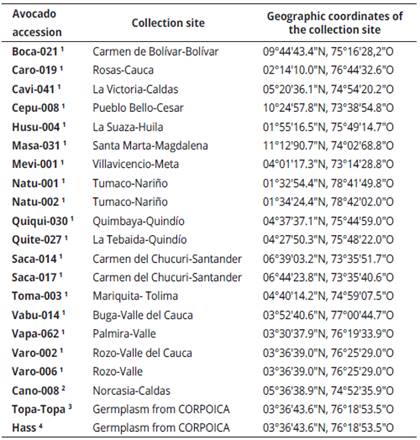
Type of selection: 1 Germplasm from CORPOICA, 2 Tolerant accession, 3 Susceptible rootstock (Gabor et al.,, 1990; Kellam & Coffey, 1985) and 4 Susceptible cultivar (Ramirez et al., 2014)
Selected materials were identified and cloned from the plant material in the Avocado Germplasm Bank of CORPOICA, Palmira Research Station. The respective agronomic management for five months was established with the aim to promote bud growth. The pruned plants were available to induce the vegetative growth, obtain new buds with the required conditions for grafting and obtain enough clonal material for the evaluation. In addition, buds from the 21 selected accessions, were collected. For the collection, it was determined the buds in optimal conditions for grafting following these methodological steps:
Selection of young branches in an active growth and medium flexibility.
Selection of bud woods of 15 cm long with a cork point in the stem centre, approximately 1 mm wide, to allow the fluid flow.
The bud woods were disinfected in a solution of Mancozeb or Benomyl (Mancozeb 80% wp, Benomyl 50 wp) at a concentration equal to 1.5 g. l-1 for five minutes.
The bud woods were placed in kraft paper and masking tape, which clearly identified with the bank accession code in order to ensure their genetic identity.
The plant material was immersed in water to assure their wetting and avoid excessive transpiration. In addition, were packed in a polystyrene cool box for transport.
Twenty-one avocado accessions were grafted on native or common rootstocks from Alvarado, department of Tolima; 12 grafts per accession to ensure the nine plants required for the infection assay and were properly identified to assure the germplasm traceability. The plants were kept three months in the nursery and the agronomic management was established as follows:
The seed used as rootstock came from a basic orchard of native or common trees propagated in a registered nursery, using the previously established management protocols. The grafting was performed at 25 cm of height in the rootstock terminal spike. Consequently, was covered with a plastic bag to conserve the humidity and a paper bag to keep it in darkness and stimulate the bud rapid growth. Each week, disease and plague control was carried out in terms of metalaxyl, fosetyl aluminium, carbendazim, potassium sulphite and chlorpyrifos rotation (Ridomil, Aliette, Carbendazim 50, Potassium sulphite E225 and Lorsban).
The grafted plants were put in a nursery under a plastic cover to control leaf moisture and water supplying, lifted off the ground 70 cm, on concreted beds and supported by a plastic pot to avoid contact among them and ensure adequate drainage. The portable weather station Watch Dog serie 2009, installed to monitor the temperature and relative humidity conditions and guarantee the required conditions for the plants and expression of the pathogen.
The optimal temperature for the infection with P. cinnamomi ranges from 21 to 30°C and there is little or no infection at 33°C or among 9 and 12°C (Andrade et al., 2012). These temperatures coincide with the growth curve observed in this study for the oomycete. The growth response of the avocado plantlets at soil temperatures is similar to the growth of plants affected by the fungus with exception of avocados with optimal growth temperature of 33°C. Likewise, moisture is a primary environmental factor that affects the occurrence of the root rot caused by P. cinnamomi and determines its development or growth, sporulation and infection process. High moisture levels in soil increase the infection due to higher formation of sporangia and appropriated conditions for the release of zoospores, mobility and movement at the infection site.
In order to keep a high relative humidity, under the concrete beds were put cement tanks with a capacity of 190 H2O l, a total of eight tanks to cover 1.52 m3. Additional irrigation was carried out every two days at field capacity to ensure optimal humidity conditions, which can lead to avoid splashing among plants.
Isolates of Phytophthora cinnamomi
Two strains of the pathogenP. cinnamomi reported as the most pathogenic isolates out of 22 strains evaluated in Hass avocado using mycelium of the pathogen by cut-stem inoculation. The isolates were collected in different regions of Colombia where the death of avocado trees were presumably caused by P. cinnamomi. The identification of P. cinnamomi was conducted by macroscopic colony growth (rosette form and petaloid type) and microscopic vegetative and reproductive structures (coraloide hyphae and globose chlamydospores).
The selected isolates were Ag A-041 collected by The Universidad Nacional de Colombia, Palmira campus, in Tribunas Córcega, Risaralda department, and Ag A-003 collected by CORPOICA- Palmira Research Station, in Rionegro, Antioquia department, respectively, according to their pathogenicity. Purification and increase of the selected strains of P. cinnamomi were carried out in the Phytophatology Laboratory in CORPOICA, Palmira Research Station.
Experimental design
A randomized complete block design (RCBD), with a factorial design in subdivided parcels was performed. The major parcels were the P. cinnamomi strains, the subparcels were the P. americana accessions and the sub-subparcels were the evaluations. Two strains (Ag A-041, Ag A-003 and the control inoculated with agar-water), 21 avocado accessions in a factorial design of 3 x 21 (63 treatments in total) and three repetitions per treatment for 189 total plants were evaluated. The evaluation of the response variable was performed every two days from the fifth day of inoculation and for 16 days.
Inoculation
The methodology used was mycelium of the pathogen by cut-stem inoculation of each plant. The cutting was performed 5 cm above the grafting point, the wound was done up-down with a disinfected scalpel without disturbing the woody part of the plant and partially removing the plant bark at 2 mm deep approximately. Inside the wound was place an agar disc diameter 6 mm with mycelia of P. cinnamomi. In addition, the wound was covered with parafilm to prevent the fall of the agar with mycelia, to control the moisture and ensure the pathogen colonisation. The control plants were inoculated with an agar disc diameter 6 mm with water.
Data analysis
Measures of the length and width of symptom progression were recorded every two days from the fifth day after inoculation and for 16 days. These values were multiplied to calculate the lesion area and establish the area under the disease progression curve (AUDPC). The results were analysed with SAS (Statistical Analysis System) software version 9.3. An analysis of variance (ANOVA) and a Tukey`s test for means comparison were performed. The information obtained from the evaluations and the statistical analysis were performed to select the promissory avocado accessions with higher tolerance to P. cinnamomi.
Results and discussion
The records of temperature and relative humidity allowed establishing that the conditions required for the expression of the pathogen and the disease were within the optimal range, according to Andrade et al., (2012). Temperature fluctuated among 21.3 and 31.9 °C and the relative humidity was higher than 51% with a maximum value of 93.8%. Eight reads of the length and width of the lesion progression were obtained and used to establish the area under the disease progression curve (AUDPC) for 1512 AUDPC data.
The variance analysis of AUDPC showed significant differences (P ≤ 0.001) for the avocado accessions, the P. cinnamomi strains, the evaluations and the interactions strain x accession, strain x evaluation, accession x evaluation and strain x accession x evaluation (Table 2). The estimated statistics for each source were based on their associated error.
Table 2 Variance analysis of the AUDPC obtained for the inoculation of 21 avocado accessions with two P. cinnamomi strains.
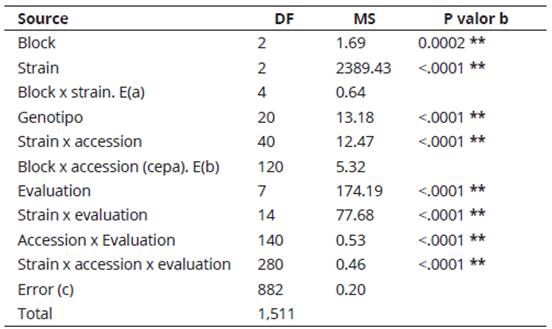
C.V: 21.2%.
DF: degrees of freedom. MS: mean square. P valor b: probability of finding higher values of F ** Significant differences
The variance analysis and the media separation using the Tukey`s test identified the strain Ag A-041 from Tribunas Corcega, Risaralda, as the most pathogenic because it had the highest AUDPC average value for the different avocado accessions evaluated. The strain Ag A-003 from Rionegro, Antioquia, showed statistical differences from the control strain Ag A-000 that was asymptomatic and had lower AUDPC average value than the Ag A-041 strain. Then the Ag A-003 strain did not register a high pathogenicity for the avocado accessions evaluated (Table 3).
Table 3 Pathogenicity levels of two Phytophthora cinnamomi strains in avocado and a control (agar plus water).

The significantly statistical differences observed among avocado accessions, involved the genotypes respond differentially to the pathogen, represented by dissimilar AUDPC average values. The tolerance levels were assigned based on the mean values determined by the Tukey`s test for the AUDPC and correspond to highly susceptible, susceptible, low tolerance, moderate tolerance and tolerant.
According to the Tukey`s test, 5% of the accessions performed the highest tolerance level. Accession NATU-001 from Nariño department, municipality of Tumaco, showed the lowest AUDPC values. Twenty nine (29%) of the accessions exhibited moderate tolerance, 57% low tolerance, 5% were susceptible and 5% highly susceptible; the avocado accession QUIQUI-030 from Quimbaya-Quindio, Colombia was the most affected and performed the highest AUDPC value (Table 4). The Hass cultivar reported as susceptible presented the second highest average AUDPC value followed by the accession CARO-019 from Rosas, Cauca, and the rootstock Topa-Topa known in United States as susceptible. These results demonstrate the cut-stem inoculation in avocado is a valid methodology to evaluate and characterize the genetic response of avocado to P. cinnamomi.
The statistically difference observed for strain x accession interaction was highly significant and means that the avocado accessions had differential responses to the inoculated strains. The strain Ag A-041 results from the most pathogenic strains, which exhibited the highest infection pressure over the evaluated accessions (Table 4).
Table 4 Tolerance levels of 21 avocado accessions from the Germplasm Bank of CORPOICA, Palmira Research Station against Phytophthora cinnamomi strain Ag A-041.
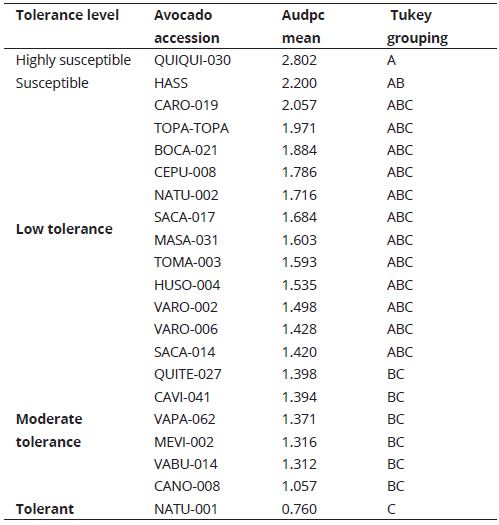
The significantly statistical difference for the AUDPC evaluations, indicates the disease progression was continuous and increasing over time. Similarly, the differences in the interactions strain x evaluation, accession x evaluation and strain x accession x evaluation confirm progression of the disease as function of time. Each avocado accession and each P. cinnamomi strain performed a disease progression that varies according to the time. The avocado accession NATU-001 had the lowest AUDPC value and QUIQUI-030 showed the highest (Figure 1). The AUDPC values of the strain Ag A-003 were 90% lower than the strain Ag A-041 and the Hass cultivar, susceptible control, showed the greatest disease progression for the last strain (Figure 2). The control Ag A-000 without pathogen did not exhibit AUDPC for any of the avocado accessions confirming that the inoculation protocol used met the required parameters to ensure good results and reducing the experimental error.
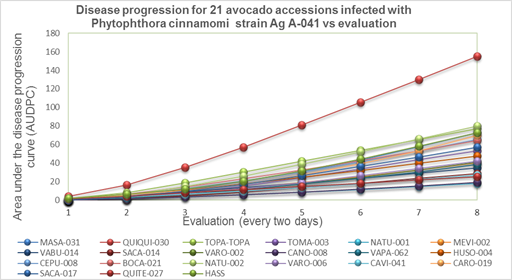
Figure 1 Tolerance levels of 21 avocado accessions against P. cinnamomi strain Ag A-041 according to the AUDPC.
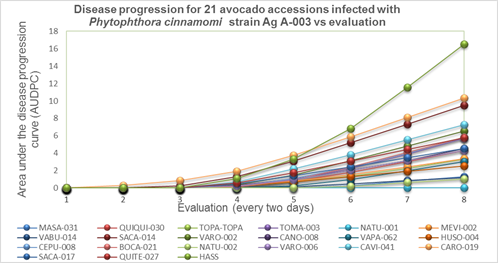
Figure 2 Tolerance levels of 21 avocado accessions against P. cinnamomi strain Ag A-003 according to the AUDPC.
The plant material with the higher tolerance level was NATU-001, collected in Tumaco, Nariño- Colombia. This place is located in the Colombian Pacific Coast, at 25 m. a. s. l., with 29 ºC average temperature and oscillations among 16 and 33ºC, relative humidity of 83.86%, annual precipitation of 2792mm.
These weather conditions are typical of the Tropical Rain Forest (TRF, the flat topography favours the terrain super saturation and flooding which are optimal conditions for the pathogen presence and development.
The nature of avocado cross-pollination, increases the genetic variability and could lead to the segregation of individuals with different tolerance levels. This could explain the NATU-002 and NATU-001 accessions behaviour, which displayed different tolerance responses in this research. The accession CANO-008 performed the second lowest AUDPC value. This accession was collected in Norcasia, Caldas, the municipality has climatic conditions of TRF, is located at 551 m. a. s. l., its average temperature is 25ºC, annual rainfall of 3675mm and relative humidity 76.76%. Norcasia weather is hot and present hard rainfall in short time, optimal conditions for the presence of P. cinnamomi, the avocado crops and for the interaction pathogen-host. Those climatic conditions are perfect for a high production of sporangia, release and movement of zoospores due to high precipitations favour the transfer of the pathogen propagules between the roots of infected trees and the roots of healthy ones using the water as their means of transport (Andrade et al., 2012). Based on this, the accessions NATU-001 and CANO-008 were collected in places with high temperature and relative humidity, ideal conditions for selecting rootstocks of avocado landraces with any tolerance degree to the root rot problem.
Conclusion
There are accessions from the Avocado Germplasm Bank of CORPOICA, Palmira Research Station with different tolerance levels to the pathogen Phytophthora cinnamomi Rands causal agent of root rot. The tolerance of the avocado accessions (NATU-001 y CANO-008) could be related with outstanding characteristics with genetic origin














